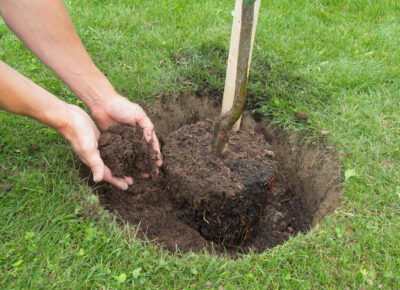A planting hole should be 2 to 3 times the diameter of the root ball. By doing this, the new roots can get established quicker and grow out to, and a little beyond the weep line. Only until that happens will the plant be able to support itself without so much supplemental watering.
Step 1: Start Digging
In the beginning we create the planting hole. The two piles represent the top soil, and the sub-soil which enable you to put it back the same way it came out. You will notice the soil has been broken up to garden seedbed texture. This is accomplished before the soil is removed from the hole by turning it over and over, just as you do when spading a garden.
By getting soil broken up to a fine texture, the roots can easily penetrate into the new ground, even in clay soils. This is an extremely important as it will also eliminate air pockets, excessive settling, and make the plant very solid in the hole after it is watered in, and we all want that, right?
Step 2: The Perfect Hole
After the hole is dug take a garden fork and scarify (scratch up) the sides so it isn’t glazed. When augers are used to dig holes, it tends to have a glazing effect on the sides of the holes, which makes it difficult for new roots to penetrate. This is especially the case with clay soils, where you can literally end up with a clay pot in the ground. Water lays in the bottom of the hole and the roots have a very tough time penetrating the surrounding soil.
Step 3: Deeper is not better
If the hole is too deep the plant will settle below grade which will create drainage and aeration problems right from the start. This is vitally important when planting in less than well drained clay soils. The goal with any transplanting is to have the plant at the same grade or even a little higher than it was in the container. When we plant here at the nursery we actually try to end up with the root ball sitting 1 to 2 in above grade and mound the dirt up to it. This helps with drainage issues plus gives the plant a little more top soil to grow in.
Step 4 Measure the Root Ball:
To make sure the hole won’t be too deep it’s a good idea to measure the root ball. After measuring the root ball the depth of the planting hole is matched up. This ensures a proper fit. Lay a shovel or board across the hole and use a tape measure as shown. We always plant things a little high, an inch to two inches above grade. This almost guarantees your plant will never settle below grade, plus it improves drainage. The back fill soil is then mounded up to the root ball.
Step 5: Inspect the Roots
This is what the roots will look like after coming out of the container. It is only natural the roots will start circling the container. You start the root unwrapping process at the bottom and work your way up and around the sides. Extra care should be taken around these fleshy white roots because they are new and tender.
Step 6: Prepare the Roots
You should never take a plant out of the pot and slap it in the ground. Have you ever pulled up a plant that died, only to find the roots had never left the original root ball. Circling roots will tend to continue to circle, and never find their way into your ground if you don’t gently untangle them before placing it in the planting hole. The wrapping roots should be gently loosened up and spread out so they will grow into the new soil. Failing to do this the roots will pretty much continue to circle, which prevents the plant from getting established and growing into the new soil.
A few roots may break off in the process, but it’s just like pruning the top of the plant in that they will be come back more fibrous and branch out more. This is a good thing! Don’t worry about losing some soil around the roots in the process, as it is important for the roots to be in contact with the soil in which they will be growing. Your plant will establish itself much sooner and require less watering by using this method of planting.
Step 7: Ready for Backfill
After the plant is set in the hole it can be turned and sited for best side, etc. As you can see by this picture the root ball is far underneath the weep line where rain would fall. So even with a heavy rain fall the root ball will not benefit. That’s why we say you have to water at least the first full year until those new roots reach out to the weep line of the plant.
Step 8 Tucking Everybody Back In:
After the plant is set in the hole and back filling has started the roots are spread out into the new soil as the hole is filled.
Step 9 The Big Finish:
The back fill begins with the sub-soil going back in first. It is easy to tell the levels apart because they will be a different color. After the hole is half back filled check to make sure it straight and then you can start watering it in, and then back fill the rest of the way and give the whole area a good soaking.

